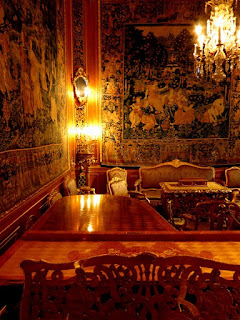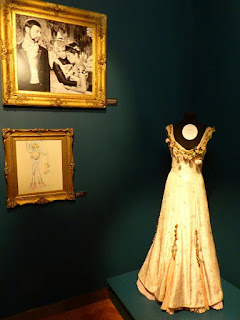Thursday, 14 December 2017
Bergman in fashion
Mighty Ingmar, that is, the centenary of whose birth we celebrate next year, not wonderful Ingrid, though I'll give her a repeat look-in at the end here. The above image of one of Bergman's greatest leading ladies, Eva Dahlbeck, in Smiles of a Summer Night, was used in a colour ad to make me slaver at the prospect of Bergman à la mode at the Hallwyl Museum (Hallwylska museet).To be honest, I wasn't so sure about the mode bit, but anything about the master while I was in Stockholm for the HK Gruber festival at the Konserthuset had to be embraced.
The actuality, curated by set and costume designer Anna Bergman and Nils Harning, teacher of Costume/Props at Stockholm University of the Arts, exceeded my wildest dreams, even if the setting, No. 4 Hamngatan close to Dramaten, the National Theatre, is a fascinating but oppressive monument to often dubious bourgeois taste. It was built for Walther and Wilhelmina von Hallwyl between 1893 and 1898 to designs by Isak Gustaf Clason. The exterior is a fanciful combination of Venetian Late Gothic and Early Spanish Renaissance.
Admission to the main rooms on the first floor - I suppose one should say piano nobile - has been free ever since the Museum, bequeathed by the Hallwyls to the nation on condition that the rooms stayed the same, opened to the public in 1938. Should you begrudge paying 80 SEK for the bulk of the exhibition in the smaller, mostly unfurnished rooms on the second floor - and you'll see further down how that would be a false economy - you may still coo at the very first room you see, shrine to the Ekdahl family Christmas, if you love Fanny and Alexander anything like as much as I do (it's still my No. 1 favourite film). By the way, these are all my photos, with permission; the catalogue doesn't have pictures of the exhibition displays, and it's all in Swedish, otherwise I'd have bought it.
There are the maids' costumes, the one worn by Pernilla August (then Östergren) as the vivacious Maj in the centre; there, too, are the gowns for the ladies of the family (the one for Gunn Wållgren's Helena Ekdahl on the right, and for Mona Malm's Alma Ekdahl in the centre).
There, too, next to an Oscar, are Alexander's sailor suit and his teddy.
J actually met the original, Bertil Guve, at a Bergman Centenary launch in London which, regrettably, I didn't make. Very friendly chap, apparently, now an engineer, there with his real-life sister.Testified to Bergman's infinite kindness and consideration on and off set.
The table is laid as for that sumptuous Christmas.
The taste of the Hallwyls, though, is rather more fustily eclectic; as a distinguished actor, presumably with connections in the artistic world, Bergman's Helena favoured something more along the clean, bright lines of the Thielska Galleriet out near the farthermost tip of the Djurgården island, still my favourite building in Stockholm alongside the art deco Konserthuset. The big showoffy room in the Hallwylska has opulent tapestries, an impressive marble relief of Abraham and Isaac above a for-show-only fireplace
and a Steinway model C delivered in 1896. Doughty Wilhelmina wanted more than just the plain pearwood look, so she commissioned Clason to make a 'Baroque' parquetry case. Restored in 1990, the piano is in fine working order, they tell me.
The exhibition has two costumes from that vulgar mess Now About These Women, one of the few Bergman films I can't stand (because, unlike Smiles, it's not funny. I don't like The Silence either, but I don't dispute its finer points).
As for the paintings in the Hallwyl collection, there are few that show much imagination other than the portrait tucked away in the corner of Walter's smoking room.
Collections of pipes, porcelain and other fripperies didn't do it for me, but at least there are a few more objects of Bergmania scattered around the other piano nobile rooms, like this costume (there's jewellery too) from the austerely masterful The Virgin Spring,
and a model of Bergman's maternal grandmother's home in Uppsala as recreated for the Bille August-directed The Best Intentions.
Costumes from that are in the first room of the exhibition's paying part upstairs
alongside some of Bergman's own working clothes (men do get a look-in from time to time). Of course I love the jacket matched to angel wings,
echoing the treasurable photo of Bergman wearing those from the nativity scene of Fanny and Alexander.
Outside in the hallway there's jewellery worn by Ewa Fröling as Emilie Ekdahl, the mother of Fanny and Alexander.
The generous placard tells us that it symbolises security for the children - the only time Emilie doesn't wear it is when she goes to live with the 'bad father' Bishop - and quotes Fröling: 'I remember when I first saw the "dog-collar"...A piece of jewellery joined together by older pieces. Extremely beautiful'. There's more jewellery, the engagement brooch worn by Bergman's mother (on whom Emilie was partly modelled), placed together with a letter below the striking photo of the parents, not quite easy - just, in fact, as played by Samuel Fröler and Pernilla August in The Best Intentions.
Now we head to the heart of the earlier masterpieces - and, in the case of the black and white films there's the fascination of seeing the actual colours we had to imagine. Thus the dress worn by Bibi Andersson as the old professor's youthful crush in Wild Strawberries
and here's striking colour to match the flamboyance of Desiree Armfeldt, the captivating heart of Smiles of a Summer Night as unforgettably played by Eva Dahlbeck.
The room also has two other costumes. As the helpfully translated panels have it, the dress designer Mago - born Max Goldstein, fleeing to Sweden from Berlin 1938 - found 'a creative outlet for his weakness for 1950s silhouettes, where slender waists, ample breasts and shapely hips dominated. As a type of "master of glamour," Mago turned the film's turn of the century into 1950s couture'. As a result Margot Carlqvist's Countess Charlotte 'is draped in duchess and chiffon with an asymmetrical cut'.
To balance, there's the provocative innocence of Ulla Jacobsson's Anne Egerman (cf Sondheim's 'You must meet my wife').
Dahlbeck's red dress is first glimpsed from a very different room.
This is a little masterpiece of exhibition design - a red room with a white dress, Ingrid Thulin's in Cries and Whispers. It mirrors, of course, the essential design concept of that harrowing work of genius.
Creepiness rules in the corridor, as two alcoves give us the clown costume from Sawdust and Tinsel - telling us that Bergman was terrified of clowns, and that he thought white clowns 'mean' - and the God-puppet from Isak's shop of wonders, the 'fourth dimension' of Fanny and Alexander.
Pure enchantment, to the strains of the Christmas-tree decoration music in Tchaikovsky's The Nutcracker, opened up in the recreation of the children's room upstairs at grandmother Ekdahl's in the same film.
And there, at the very centre, is the toy theatre with which Alexander is seen playing at the start of the film.
One sumptuous male costume gets a look-in - the kaftan of the caddish actor-seducer played by Hasse Ekman in Sawdust and Tinsel.
Opposite are two more gowns for Gunn Wållgren's Helena - I love that touching photo. Wållgren knew she was dying from cancer when she made the film, which surely gives her superb, still sensuous performance an extra pathos.
Death stalks the next room.
The deepest resonance in the film for me was when Alexander's father is dying and the boy, taken into the room, hides under the bed. It wasn't quite like that, visiting my dad on the last night of his life in hospital - in fact it was a lot worse - but I did identify with him. So I wasn't unflattered when two Swedish ladies told me, unprompted, I was Alexander. Fortunately I didn't exercise any powers on my stepfather, whom I was old enough to tolerate. Anyway, here's another nice composition - the boy's funeral suit, and a photo of young Ingmar similarly attired.
In an excellent final flourish, the corridor back to the staircase has a fine selection of Bergman's boyhood drawings.
No surprise that he already saw himself as a filmmaker at an early age.
Even this little collection would have been worth the price of admission. As it turned out, the whole exhibition was a thing of amazement to me. Oh, and just to give Ingrid Bergman a look-in - we must watch The Visit again some time soon - I take the liberty of repeating one of my all-time favourite magazine covers as symmetry to the Dahlbeck picture at the top.
Subscribe to:
Post Comments (Atom)







































4 comments:
Your comment, not being sure about "the mode bit," would certainly be my "mode," too, but you've amply demonstrated why this particular fashion display was so much more interesting and resonant than one might expect. (The Met Museum, as you may be aware, has a huge fashion extravaganza every year. The benefit for the Costume Institute that accompanies the exhibits has become a parade of celebrities akin to the Oscars and all the more unappealing for that, though it will be interesting to see how the Met handles the benefit in 2018, when the theme is "Heavenly Bodies: Fashion and the Catholic Imagination.")
Sue, I may have got this wrong but I think in a conversation some time back you said you hadn't seen Fanny and Alexander. If you still haven't, will you and J sit down and watch it for me this Xmas, please? The full TV version - the 'theatrical' (ie cinema) edition misses out so many wonderful scenes. Anyone who loves theatre (especially Shakespeare) and great acting as well as superb cinematography should love it. If you can't face it, Smiles of a Summer Night would do. But of course I may, as I wrote, be wrong.
I've decided, especially after nine series of RuPaul's Drag Race, that I do love a well-designed frock. Next I'll be making one myself...
I won't be able to watch it again over the holidays, but I have seen it & recall enjoying it. It's possible I watched it after you mentioned it the first time, though somehow I feel I saw it longer ago than that, not sure. I'm not so fond of frocks, though if you were to make one, that would for sure be quite the thing to see!
Ah well, horses for courses, I guess. But above all, DO read The Peregrine, which I tried to foist on people lower down here. That's great writing, regardless of whether the subject interests (and I think it would interest you), just as F&A is great filmmaking.
Post a Comment